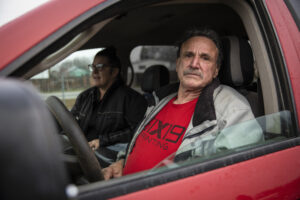Emerald Triangle communities were built on cannabis. Legalization has pushed them to the brink

HAYFORK — It’s shortly before 8 a.m. and a touch above freezing at the Trinity County Fairgrounds. The food bank’s February distribution won’t begin for another half hour, but the line of cars already stretches into a third row of the parking lot.
Joseph Felice, his red Dodge pickup idling with the heat cranked up, arrived around 7 to secure a spot near the front — eighth, to be exact — and ensure that he gets his pick of this month’s harvest: frozen catfish filets, eggplant, winter squash, potatoes, cans of mixed fruit, cartons of milk. Getting here early is crucial, because by the time the final cars roll through some two hours later — 210 families served — all that’s left are a few packages of diapers and noodles.
Things are getting desperate in this remote, mountainous community in far northern California, where cannabis is king — the economy, the culture, the everything. Over the past two years, the price of weed has plummeted and people are broke.
The monthly food bank distribution moved from a church to the fairgrounds last summer to accommodate surging demand. There’s only one sit-down restaurant left in town, a Mexican joint that closes every day at 6. Some residents have fled for Oklahoma, where it’s easier for cannabis cultivators to get licensed. Others are stuck, unable to unload their properties amid an abundance of supply and a dearth of demand.
“I don’t see the same faces that I did before,” said Felice, 67, who performed maintenance work for a local grower for five years, until they called it quits at the end of last season.
Felice lost not just his income, but also free housing on the farm. The food distribution is now a crucial bridge between Social Security checks and trips to Redding, 60 miles away, where he can get cheaper groceries.
“I had plenty of money working out there,” Felice said. “But now that it’s gone, you have to do something.” Read more >>>